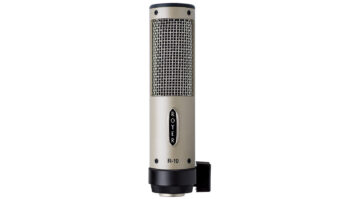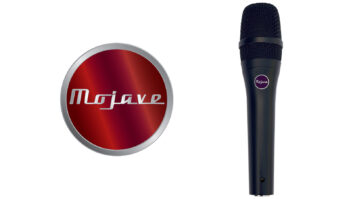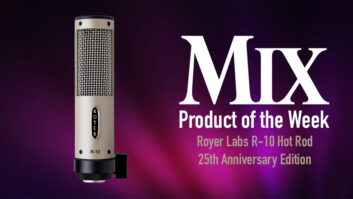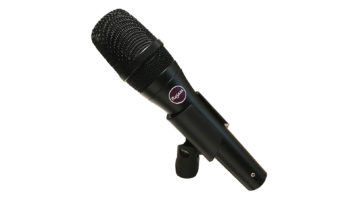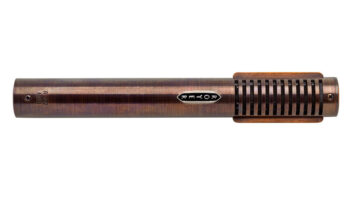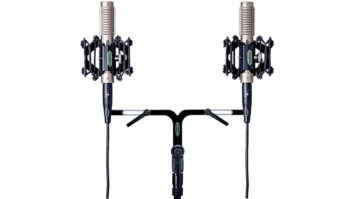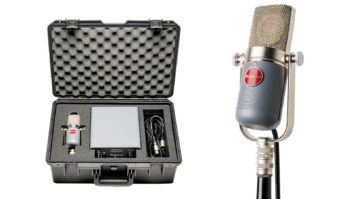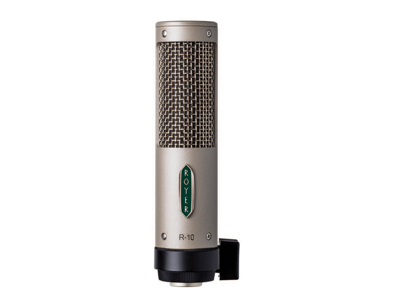
ROYER R-10 RIBBON MICROPHONE
The name Royer slips off the tongue as easily as studio standard ribbons like RCA, AEA, Beyerdynamic and others. The R-121 is a favorite of engineers and studios who can afford its $1,295 price tag; until now, the only ribbon mic under $1,000 was the R-101 at $699, but the passive R-10 beats that. The new mic bowed just last month and sells for an as- tonishing $499 street.
Royer’s John Jennings offered that the mic uses the same internally shock-mounted ribbon transducer as the R-121, made in-house at Royer’s California factory. What differs is the outer appearance and the transformer, which alters the personality just a bit. Also onboard is a multi-layered wind screen to protect the ribbon element. The R-10 utilizes Royer’s patented off-set ribbon technology, which helps its SPL handling and also gives a slightly brighter response on the back side of the mic if the instrument (or singer) is 3 feet or closer to it. The mic comes in a sturdy, padded case with mic mount and logoed Royer mic sock. I had a pair of the mics in use around Blackbird Studio and they are astonishing, making me want to bring them out on every session, often in place of an R-121. Of course, the first question out of anyone’s mind is, “How does the R-10 compare to an R-121?” The answer is simple: The mids and top are nearly equal, but the R-10 has a fuller booty, necessitating an HPF on occasion.
On a Fender Deluxe combo amp up close on a speaker next to an SM57 it was never out of place or disappointing. The mics were gained using the stock 31105s on Blackbird’s Neve 8078 in Studio A. The mid and top edge paired well with the 57, and the R-10, when called upon. brought a fullness to the bottom end of the track. If any- thing, it needed some EQ push at 2.5 kHz, but that’s standard when I cut electric guitars.
In use around a drum kit, as a mono room mic, the R-10 was full-bodied and represented the drum kit very well, top to bottom. The great thing about ribbons, in general, is that they accept EQ at the top end very well, and be- ing naturally rolled off, they of- ten need the boost. In this case, I shelved above 6.8 kHz and added a touch of bottom end below 100 Hz. This brought the boom and top to the signal that paired nicely with the R-10’s sweet midrange.
On various hand percussion the R-10 did what ribbons do— rolled off the top, which can be harsh when recording shaker or tambourine. Because of the bigger bottom end, a highpass filter was employed but the mid and top were perfect and very reminiscent of an R-121.
Where I absolutely loved the mic was recording the fiddle of Third Man Records recording artist Lillie Mae. I often use ribbons for this application because of the instant beauty they bring to a sometimes scratchy and exposed upper midrange and top. It’s not so bad in a section when the mics are at a distance, but a close-miked solo violin in an iso booth can be a challenge. I placed the R-10 18 inches to 2 feet above the fiddle and used an SSL 9K preamp and channel to get into Pro Tools. It was instantly beautiful in the track and needed no EQ. That application alone is worth the price of entry. If you record strings, you can’t ignore this mic.
Finding a new ribbon with a solid pedigree and at such a price is like striking gold. The Royer R-10 is an instant classic that is a must for any mic locker, high-end or low. And at this price, you can have a pair.

The MA-1000 uses an NOS 5840 tube and custom transformer from Coast Magnetics.
MOJAVE AUDIO MA-1000
Mojave Audio, a companion company to Royer (with designs by founder David Royer), specializes in making condenser mics of many types. Its latest offering, the MA-1000, draws from the company’s expertise in electronics and capsule design. But the price forced a double-take when I first saw the mic at Winter NAMM 2017. Mojave’s mics have hovered below and above the $1,000 mark, but the MA-1000 tops out at $2,795 street. I was curious about what this new mic offered to justify the price.
The MA-1000 uses a purpose-built transformer from Coast Magnetics, an original NOS 5840 tube, and 3-micron, 1-inch gold-sputtered capsule. Features on the power supply include continuously variable pattern control from Omni to figure-8, a highpass filter at 100 Hz (6 dB per/octave), and a switchable -15dB pad. The mic comes with an impressive carrying case housing the mic, power supply, Sling-Shock shock mount and cables.
The first application was over a drum kit. It was open and represented a stereo picture of the kit very well without being strident. I tried the mics in both cardioid and omni, finally settling on the former be- cause it focused the kit more in the large room. Both patterns sounded great; it was just a matter of preference for this session and style of music.
On another session, I used the pair for recording toms on a drum kit. It needed little EQ help, and the transient hits were beautifully rendered. I regularly hear U67s, Josephson e22s, and TLM-107s in this application, and the MA-1000 brings its own signature to close-miking. The bottom end is full, but for me needed some boost at 100 Hz. The stick hit and top were beautiful and responded well to a little sweetening above 6 kHz.
Next, I used an MA-1000 for tambourine and shaker. The MA-1000 sounded very good representing the sometimes out-of-control jangling of the tambo very well. The pair of mics up close on a Yamaha C7 piano captured the instrument beautifully. The piano in Blackbird’s studio A is bright and full, and the mics stood up toe to toe with a player who could play from f to fff in a moment. Transients were crisp without distortion, and the bottom end was sonorous.
On acoustic guitar, a single MA-1000 shined when paired with a Neumann KM56. The MA-1000 was set up pointing at the low end of the instrument while the KM sat near where the neck meets the soundhole. Both mics rendered an excellent stereo picture of the expertly played guitar.
The Mojave MA-1000 is an excellent microphone that brings a smooth, evenly tempered response across a range of applications. It’s great around a drum kit either overhead or up close on toms. It also excels on acoustic instruments like guitar, piano and percussion. Highly recommended if you can swing the price.
